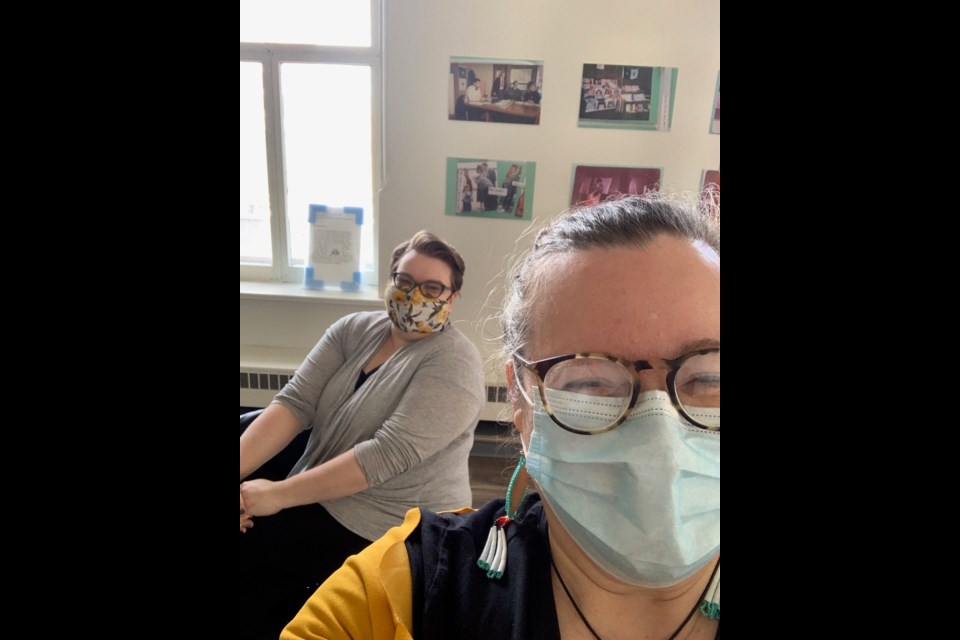In early March, the Sault Ste. Marie Museum announced it would be opening its doors to the public to display its first ever residency exhibit. The Museum inaugurated its exhibit on March 25 but was forced to close due to the provincewide lockdown just a few days later.
The exhibit is a culmination of months of work by Isabelle Michaud, the artist in residence, which pays homage to Northern Ontario’s rich francophone culture. The Museum is now looking for ways to let the show go on.
Born in Québec City, Michaud is a French professor at Algoma University and a board member at the Centre francophone de Sault-Ste-Marie. She has worked on past art projects that highlight francophone identity in Northern Ontario.
In October of this year, Michaud was approached by the museum’s outreach and programming coordinator, Katie Huckson, about a residency. As she was touring the museum to start out her research Michaud said, “I could see the [exhibits displaying] voyageurs and the coureurs des bois.”
“It’s from a distant past when francophones were here and then they left. If you looked at the museum, you’d think francophones weren’t living here outside of the 1700s,” she told SooToday.
But further research – as well as her own existence as a French woman in the Sault – suggested otherwise.
“When I started looking at other books and documents, I saw that francophones were here from the early 1700s to now.”
Michaud held her next stage of research looking through the archives of the museum and the Centre francophone. She noticed a marked absence of evidence of francophone culture.
Not one to give up, Michaud continued her investigation by recording oral histories, interviewing locals and travelling to the abandoned Église Saint-Ignace. During this phase of research, she spoke to linguistics professor Sean Meades, who told her about the historic neighbourhood called French Town.
“That was the first time I had heard the words ‘French Town’. I went looking for more information. I couldn’t find anything in the library, at the university, anywhere. I felt like a whole world had been lost. So I decided to base the work on this feeling of not being fully here — almost erased.
“I painted some scenes on paper that are very light, almost faded, then I cut these huge circles and spun them together on long yarn, which I hung from the ceiling, and it goes right down to the floor.”
This work now sits in the centre stage of her installation, which she gave the bilingual name Walking French Town/Une balade à French Town. Other aspects of the installation include paintings inspired by Ojibwe artist Carl Beam and a cabinet in honour of the Dionne Quintuplets from Callander, ON.
The artist notes that her work is “not hyper-realistic or what we call in the visual arts, representative . . . They are sketches and expressionistic and sort of faded as well.”
What was she trying to represent? Michaud points to a “sort of cut-and-past feeling."
“We are existing within a majority and we speak French together but the rest of the time we speak English . . . The French feeling is often one of assimilation. We feel unseen.”
However, with the lockdown, the whole museum is “closed to the public but [still has] run some virtual programming,” said Huckson. But that is not stopping them from virtually showing its work as much as possible.
“We partnered with the city's Senior Services 55+ for a virtual tour and artist talk with Isabelle in mid-April. We've also run other virtual tours of exhibits unrelated to Walking French Town.”
“We are fortunate to have the Walking French Town/Une Balade à French Town exhibition up at least through the end of May, and may possibly extend that.
“Assuming the lockdown ends, we will resume as we have operated throughout the pandemic, which is by appointment with limited numbers of guests allowed at a time, with masks and physical distancing measures in place.”
The goal of shining a light on the unseen is part of a larger effort within the Sault Ste. Marie Museum:
“A lot of the local records focus on British history,” said Huckson. “There’s not a lot about French communities, Indigenous communities. We wanted to start this residency to address these gaps in our record.”
Huckson, a visual artist herself, noted that “art is a great intervention with an issue like gaps in our records. Artists look into the context of the problems they're working on. If there's not a lot there, art can be a great way to look into what could be.”
The Museum is using art and other community-based projects as tools to focus on Northern Ontario’s diversity. “Our next residency will have an Indigenous local artist, addressing a similar gap in our record. We also did our project with the Local Immigration Partnership and Art Speak Project. We called it Newcomer Café.” They are in the process of applying for funds from the Ontario Arts Council for the next residency.
